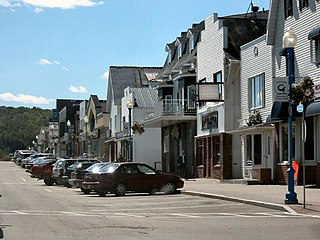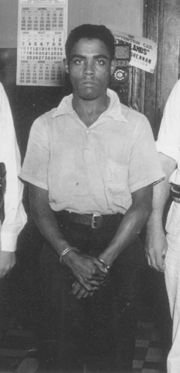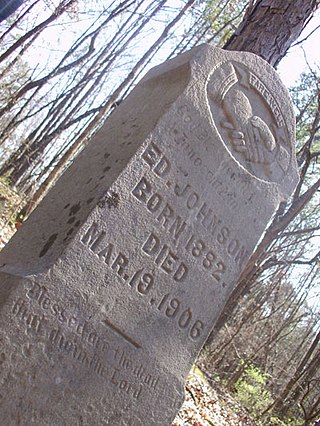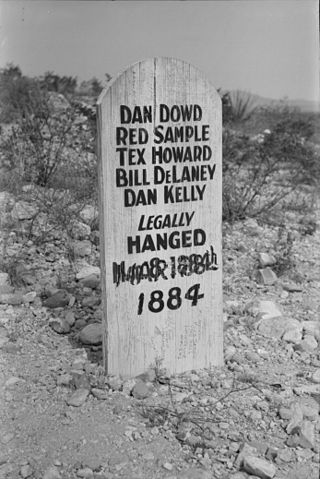"Dust" is episode 48 of the American television anthology series The Twilight Zone. It originally aired on January 6, 1961, on CBS, and was the 12th episode of the second season. The episode was written by series creator Rod Serling, and was directed by Douglas Heyes. It starred Thomas Gomez in his second appearance on the show following "Escape Clause", as well as Vladimir Sokoloff, in the first of his three appearances on the series. It is one of the few episodes that does not contain any fantasy or science-fiction elements. It also featured [John Alonzo] as Luis. Alonzo went on to become one of Hollywood's top camera DP's. [Chinatown, Norma Rae, Meteor Man].

Albert Pierrepoint was an English hangman who executed between 435 and 600 people in a 25-year career that ended in 1956. His father Henry and uncle Thomas were official hangmen before him.

Woodstock is a town in Carleton County, New Brunswick, Canada on the Saint John River, 103 km upriver from Fredericton at the mouth of the Meduxnekeag River. It is near the Canada–United States border and Houlton, Maine and the intersection of Interstate 95 and the Trans-Canada Highway making it a transportation hub. It is also a service centre for the potato industry and for more than 26,000 people in the nearby communities of Hartland, Florenceville-Bristol, Centreville, Bath and Lakeland Ridges for shopping, employment and entertainment.

Grand Falls is a town in northwestern New Brunswick, Canada, on the Saint John River. Its name comes from a waterfall created by a series of rock ledges over which the river drops 23 metres (75 ft).

Ronald Joseph Ryan was the last person to be legally executed in Australia. Ryan was found guilty of shooting and killing warder George Hodson during an escape from Pentridge Prison, Victoria, in 1965. Ryan's hanging was met with public protests by those opposed to capital punishment. Capital punishment was abolished in all states by 1985.

Thomas Edward Ketchum was an American cowboy who later became an outlaw. He was executed in 1901 for attempted train robbery. The execution by hanging was botched; he was decapitated because the executioner used a rope that was too long.

Rainey Bethea, was the last person publicly executed in Kentucky. Bethea, who confessed to the rape and killing of a 70-year-old woman named Lischia Edwards, was convicted of her rape and publicly hanged in Owensboro, Kentucky.

Roxalana "Roxana" Druse, was the last woman hanged in the state of New York, and the first woman hanged in 40 years in Central New York. Her botched execution didn't kill her instantly, further motivating New York officials to replace the gallows with the electric chair in New York in 1890.

Frank Broadstreet Carvell, was a Canadian lawyer, businessman, and politician.
Frederick Harding Hale was a Canadian lumber merchant and politician.
Mary Mabel Bennett Rogers was the last woman legally executed by Vermont. Rogers was hanged for the 1902 murder of her husband, Marcus Rogers.
Washington Goode was an African-American sailor who was hanged for murder in Boston in May 1849. His case was the subject of considerable attention by those opposed to the death penalty, resulting in over 24,000 signatures on petitions for clemency to Massachusetts governor George N. Briggs.

On March 19, 1906, Ed Johnson, a young African American man, was murdered by a lynch mob in his home town of Chattanooga, Tennessee. He had been wrongfully sentenced to death for the rape of Nevada Taylor, but Justice John Marshall Harlan of the United States Supreme Court had issued a stay of execution. To prevent delay or avoidance of execution, a mob broke into the jail where Johnson was held, and abducted and lynched him from the Walnut Street Bridge.

Laura and L. D. Nelson were an African-American mother and son who were lynched on May 25, 1911, near Okemah, Okfuskee County, Oklahoma. They had been seized from their cells in the Okemah county jail the night before by a group of up to 40 white men, reportedly including Charley Guthrie, father of the folk singer Woody Guthrie. The Associated Press reported that Laura was raped. She and L. D. were then hanged from a bridge over the North Canadian River. According to one source, Laura had a baby with her who survived the attack.
Horace Victor Dalling (1854-1931) was a Canadian watchmaker, jeweller, optician and inventor. He was the watch inspector for the Canadian Pacific Railway, and is also known for manufacturing the first two telephones in Woodstock, New Brunswick, which he placed in his store and in his home.

The Bisbee massacre occurred in Bisbee, Arizona, on December 8, 1883, when six outlaws who were part of the Cochise County Cowboys robbed a general store. Believing the general store's safe contained a mining payroll of $7,000, they timed the robbery incorrectly and were only able to steal between $800 and $3,000, along with a gold watch and jewelry. During the robbery, members of the gang killed five people, including a lawman and a pregnant woman. Six men were convicted of the robbery and murders. John Heath, who was accused of organizing the robbery, was tried separately and sentenced to life in prison. The other five men were convicted of murder and sentenced to hang.
Michael Wayne McGray is a Canadian serial killer convicted of killing seven individuals between 1985 and 1998. He claims to have killed eleven others during the same time period.
Henry Augustus Connell was a Canadian businessman and politician who was Mayor of Woodstock, New Brunswick, and a member of the Legislative Assembly of New Brunswick.

Joseph "Jody" Hamilton was an American mass murderer who was executed in Missouri. On October 12, 1906, he murdered five members of the same family, including three young children, during an argument over a horse saddle. After his arrest, Hamilton pleaded guilty and was sentenced to death. Dismissing any offers for leniency, Hamilton was executed in December of that year.
Adriano Domingo was the final civilian executed by the Territory of Hawaii prior to their abolition of the death penalty in 1957. Domingo was sentenced to death and hanged for the murder of Helen R. Sakamoto, a 21-year-old secretary, in Kauai on August 3, 1943. Although Domingo's execution made him the final civilian executed by the Territory of Hawaii, there were several executions that took place there during and after World War II for military crimes, some of which were not committed in Hawaii.












